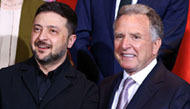KYLE CRICHTON - ESSAY
Nikolai Kondratieff was not exactly a faceless bureaucrat in post-revolutionary Russia. He had held an important economic post in the last government of Alexander Kerensky before the Bolsheviks took charge, then became an important theorist of the New Economic Policy under Lenin.
But he would long ago have been consigned to the dustbin of history had it not been for his quirky academic passion, which he pursued in books and papers through the 1920s. Reviewing economic history since the late 18th century, Kondratieff came to a startling doomsday conclusion: that capitalist economies were fated to go through predictable cycles of around 50 years, inevitably culminating in a depression.
Despite having become a committed Communist and the author of a theory of inevitable if periodic capitalist collapses, Kondratieff was executed in 1938, a victim of the Stalinist purges. Apparently he had raised too-trenchant questions about the government’s enthusiasm for heavy industry and agricultural collectives. After eight years in the gulag, he left behind a final letter to his daughter, poignantly urging her to be“a clever and good girl”and “not to forget about me.”
It was a fitting epitaph, for whenever it seems Kondratieff is about to be forgotten, the economy plunges. And once again he is back in the news, which his disciples try to fit into the cycles, or “Kondratieff waves,”that he described.
Kondratieff identified four stages in each cycle, corresponding to the seasons. After spurting ahead in the spring phase, they said, the economy cruises through the summer, experiences a scary drop as autumn sets in, and then - no matter what governments do to try to ward it off - descends into a winter phase that can last up to 20 years.
In case you hadn’t noticed, it has been getting quite chilly lately.
Over the years, Kondratieff’s appeal has risen and fallen, losing favor in good times but charging back when things look bleak. But his theory has never been accepted by mainstream economists.
Kondratieff’s supporters have cried depression before, for example in 1982. Reporting on the attention his theory was getting during that downturn, a New York Times correspondent, Paul Lewis, wrote: “According to Kondratieffian analysis, the world is caught in the fourth great economic downswing since the 1790s, a period of global recession that will probably last until near the end of the century when a new age of prosperity will begin - and there is little anyone can do about it.”
Today, Kondratieff’s disciples are just as certain that the current bad times began in 2000, with that year’s stock market crash. That was followed by the autumn phase of the Bush years, characterized by an enormous expansion of debt and leverage in an attempt to maintain the prosperity of the spring and summer years.
Evidently, Kondratieff waves tend to be in the eye of the beholder. After all, the American economy ultimately shrugged off several market drops like that of 2000, allowing the 25 years that followed 1982 to be a period of largely uninterrupted growth. But in the last decade of that period, growth was driven by debt in a desperate attempt to maintain an unsustainable level of consumption, a stage that Kondratieff’s theory quite accurately describes.
“The people who do the predicting are usually not central within the discussion of economics,”said David Colander, an economic historian at Middlebury College in Vermont. But economies do“have this tendency to exceed”that Kondratieff and others have grasped, he added, and that is largely lost in modern economic theory.
He offers the Austrian School as a possible rival to Kondratieff’s line of thought. Austrian economists tend to emphasize a laissez-faire approach to entrepreneurship and strict limits on money supply growth.
While considered outside the mainstream, the Austrian School is far more respectable, counting in its ranks two Nobel Prize winners, Friedrich Hayek and James Buchanan. Peter Schiff of Euro Pacific Capital, an adviser to the libertarian presidential candidate Ron Paul, also subscribes to its theories.
Hayek is said to have successfully predicted the Great Depression, and some Austrian School devotees are taking credit for calling this one.“The financial meltdown the economists of the Austrian School predicted has arrived,”Mr.Paul wrote in September, 11 days after Lehman Brothers filed for bankruptcy.
In the 1930s, John Maynard Keynes displaced Hayek and the Austrian School in intellectual popularity. The Austrian line of thought made something of a comeback in the Reagan years, but never quite gained acceptance in the economic fraternity, Mr.Colander says.
“It probably should,”he says.“A good profession should take its outsiders more seriously. They make you look at things in different ways. The worst thing for policy makers is to think they are right.”
스마터리빙
more [ 건강]
[ 건강]이제 혈관 건강도 챙기자!
[현대해운]우리 눈에 보이지 않기 때문에 혈관 건강을 챙기는 것은 결코 쉽지 않은데요. 여러분은 혈관 건강을 유지하기 위해 어떤 노력을 하시나요?
 [ 건강]
[ 건강]내 몸이 건강해지는 과일궁합
 [ 라이프]
[ 라이프]벌레야 물럿거라! 천연 해충제 만들기
 [ 건강]
[ 건강]혈압 낮추는데 좋은 식품
[현대해운]혈관 건강은 주로 노화가 진행되면서 지켜야 할 문제라고 인식되어 왔습니다. 최근 생활 패턴과 식생활의 변화로 혈관의 노화 진행이 빨라지고
사람·사람들
more
[송년행사 화보] “이웃과 함께 나누고 지인과 함께하니 행복”
KYCC13일 윌튼 플레이스 초등학교에서 열린 ‘한인타운청소년회관(KYCC) 홀리데이 카니발’이 성황리에 막을 내렸다. 올해는 KYCC 창립 …

[송년행사 화보] “ ‘손에 손잡고’ 한 해 마무리… 건강과 행복 기원”
전주고·북중남가주 전주고·북중 총동창회(회장 백규종)의 2025년 정기총회 및 송년회가 지난 14일 LA 작가의 집에서 성황리에 열렸다. 이날…
[송년행사 화보] “한 해를 마무리하며… 화기애애…
LA 러너스클럽LA 러너스클럽(회장 김두병)은 13일 작가의 집에서 80여명의 회원과 가족이 참석한 가운데 송년회를 마쳤다. 2007년 창립된…
[송년행사 화보] “웃음과 감사 가득 ‘훈훈’… …
한국학교총연합회미주한국학교총연합회(회장 이영숙)가 주최한 제43회 장기 근속교사 포상 및 송년의 밤 행사가 140여명의 교사들이 참석한 가운데…
[송년행사 화보] “친구야 반갑다… 선배님들 모두…
경남중고경남중·고등학교 남가주 동창회(회장 예해덕)는 지난 6일 송년회를 열고 동문 및 가족 60여 명이 참석한 가운데 끈끈한 우정을 확인했다…
많이 본 기사
- 트럼프 “내년봄 최대규모 세금환급…군인 145만명에 특별지급금”
- LA산불 여파 ‘심각’ 지역 주민 건강악화
- 백악관 역대 대통령 사진에 악플 단 트럼프… “슬리피 조, 최악”
- ‘돈봉투 수수’ 민주당 전현직 의원들 2심 무죄…1심 뒤집혀
- 크리스마스 연휴 겨울폭풍 남가주 연안 2~4인치 비
- 트럼프, ‘알코올중독 성격’ 발언한 비서실장에 “계속 직책수행”
- 뱅크오브호프, 규모도 1위·봉사활동도 ‘으뜸’
- LA 소파이 스테디엄 8경기 확정
- “신뢰감 있는 이미지”..김도훈, 광고계 러브콜 쇄도
- 한국 축구, 태백산급 고지대 난관… “손흥민 감아차기도 제동”
- 미 북서부는 홍수, 동부는 폭설 사태 비상
- 거래 더디지만 균형 회복… 리얼터닷컴 내년 주택시장 전망
- 중고차 주행거리 조작 ‘주의보’
- 위성락 안보실장, 美에너지장관 면담…우라늄농축 등 논의한듯
- 가주 신차판매 증가… 전기차 비중은 전국 최고
- 브라운대 한인학생, 총격참사 극적 생존
- 뉴욕, OKC 잡은 샌안토니오 꺾고 NBA컵 첫 우승
- [로터리] 지멘스가 만드는 미래 동네
- [지평선] 판다 없는 일본
- “김하성, 애슬레틱스 4년 4천800만달러 거절”
- “연방 전기차 충전 인프라 지원 중단은 위법”
- ‘천의 얼굴’ 루푸스… “젊은 여성, 이유 없는 발진·탈모 있으면 의심해야”
- 구글, 경량 AI모델 출시 ‘제미나이3플래시’ 배포
- [수잔 최 변호사의 LIFE &] AI 시대 편리함에 안주하지 말자
- [여명] 금붕어를 키우는 오지선다형 수능
- 테슬라, 자율주행 과장광고 적발
- 한미식품상총연협회, 송년행사·장학금 수여
- 비트코인, 역대 네번째 연간 하락세
- 김유정, 이번엔 귀신이다.. ‘복수귀’서 박지환→조여정과 호흡
- ‘신인감독’ 신드롬 어디까지?..김연경, 또 해냈다
- 한식세계화협회, 정기 이사회 개최
- [와이어바알리] “감사 이벤트… 최대 15달러 쿠폰 제공”
- [송년행사 화보] “이웃과 함께 나누고 지인과 함께하니 행복”
- 치솟는 원·달러 환율… 1,480원대 찍어
- [윌셔에서] 잠시 멈추어 서서
- 자폐 어린이 돕기 ‘신년 나눔 음악회’
- ‘항염증 식단’ 정답은 균형… 전체적 패턴이 중요
- 내년에 집 팔려면, 어떤 준비가 필요할까?
- 통증 양상 다른 여성 심혈관질환
- 5년 규칙은 옛말… 집 사고 10년은 보유해야 본전
- [왈가 왈부] 쿠팡 김범석 “글로벌 CEO라 불출석”… ‘맹탕’ 청문회 불보듯
- 워런 버핏의 투자자 위한 핵심 조언은
- 컨설팅 제왕 맥킨지 수천명 감원 칼바람
- 나스닥, 23시간 개장 추진 해외 투자자 접근성 개선
- 부동산 구입의 과정
- 2026년 미국 부동산 NAR 전망
- 2026년 미국 주택 시장의 동향
- 기업들, ‘트럼프 상호관세 토해낸다’에 베팅
- “야, 매운맛 좀 보자”..차승원·추성훈, ‘15년 우정’의 ‘차가네’
- 시드니 총기난사범, 인도 출신 이민자
1/5지식톡

-
 ☝️해외에서도 가능한 한국어 선생님…
0
☝️해외에서도 가능한 한국어 선생님…
0이 영상 하나면 충분합니다!♥️상담신청문의♥️☝️ 문의 폭주로 '선착순 상담'만 진행합니다.☎️ : 02-6213-9094✨카카오톡ID : @GOODEDU77 (@골뱅이 꼭 붙여주셔야합니다…
-
 테슬라 자동차 시트커버 장착
0
테슬라 자동차 시트커버 장착
0테슬라 시트커버, 사놓고 아직 못 씌우셨죠?장착이 생각보다 쉽지 않습니다.20년 경력 전문가에게 맡기세요 — 깔끔하고 딱 맞게 장착해드립니다!장착비용:앞좌석: $40뒷좌석: $60앞·뒷좌석 …
-
 식당용 부탄가스
0
식당용 부탄가스
0식당용 부탄가스 홀세일 합니다 로스앤젤레스 다운타운 픽업 가능 안녕 하세요?강아지 & 고양이 모든 애완동물 / 반려동물 식품 & 모든 애완동물/반려동물 관련 제품들 전문적으로 홀세일/취급하는 회사 입니다 100% …
-
 ACSL 국제 컴퓨터 과학 대회, …
0
ACSL 국제 컴퓨터 과학 대회, …
0웹사이트 : www.eduspot.co.kr 카카오톡 상담하기 : https://pf.kakao.com/_BEQWxb블로그 : https://blog.naver.com/eduspotmain안녕하세요, 에듀스팟입니다…
-
 바디프렌드 안마의자 창고 리퍼브 세…
0
바디프렌드 안마의자 창고 리퍼브 세…
0거의 새제품급 리퍼브 안마의자 대방출 한다고 합니다!8월 23일(토)…24일(일) 단 이틀!특가 판매가Famille: $500 ~ $1,000Falcon: $1,500 ~ $2,500픽업 & 배송직접 픽업 가능LA…
케이타운 1번가
오피니언
 수잔 최 한미가정상담소 이사장 가정법 전문 변호사
수잔 최 한미가정상담소 이사장 가정법 전문 변호사 [수잔 최 변호사의 LIFE &] AI 시대 편리함에 안주하지 말자
 김도년 성균관대 건축학과 교수 스마트도시·건축학회장
김도년 성균관대 건축학과 교수 스마트도시·건축학회장 [로터리] 지멘스가 만드는 미래 동네

[여명] 금붕어를 키우는 오지선다형 수능
 허경옥 수필가
허경옥 수필가 [윌셔에서] 잠시 멈추어 서서
 양홍주 / 한국일보 논설위원
양홍주 / 한국일보 논설위원[지평선] 판다 없는 일본

[왈가 왈부] 쿠팡 김범석 “글로벌 CEO라 불출석”… ‘맹탕’ 청문회 불보듯
 정숙희 논설위원
정숙희 논설위원칠레에서 영국까지, 27년을 걷다
 마크 A. 시쎈 / 워싱턴포스트 칼럼니스트
마크 A. 시쎈 / 워싱턴포스트 칼럼니스트 [마크 A. 시쎈 칼럼] MAGA와 ‘힘에 바탕한 외교정책’
 김동찬 시민참여센터 대표
김동찬 시민참여센터 대표 [미국은 지금] 위기의 시대, 사회안전망은 최후의 방어선이다
1/3지사별 뉴스

팰팍 최대규모 주상복합단지 들어서나
뉴저지 팰리세이즈팍 사상 최대 규모의 초고층 주상복합단지가 한인 개발업체에 의해 추진되고 있는 것으로 알려지면서 관심이 집중되고 있다. 팰팍…
연말 1억2천만명 이동

에어 프레미아 취항, 기대 컸나
에어 프레미아의 워싱턴 덜레스 국제공항과 인천국제공항간 취항이 확정된 가운데(본보 15일자 A1면), 에어 프레미아 항공권 가격이 당초 기대에…
VA·MD 등 21개주, 우버 상대 소송 제기

베이지역 스포츠팀, SF 한인회에 후원금
샌프란시스코 베이지역 한인회(회장 김한일)는 한인 메이저리거 이정후 선수의 소속팀인 샌프란시스코 자이언츠(San Francisco Giants…
불자커뮤니티 20일 청소년발표회및 송년회

오늘 하루 이 창 열지 않음 닫기 



















































.png)


댓글 안에 당신의 성숙함도 담아 주세요.
'오늘의 한마디'는 기사에 대하여 자신의 생각을 말하고 남의 생각을 들으며 서로 다양한 의견을 나누는 공간입니다. 그러나 간혹 불건전한 내용을 올리시는 분들이 계셔서 건전한 인터넷문화 정착을 위해 아래와 같은 운영원칙을 적용합니다.
자체 모니터링을 통해 아래에 해당하는 내용이 포함된 댓글이 발견되면 예고없이 삭제 조치를 하겠습니다.
불건전한 댓글을 올리거나, 이름에 비속어 및 상대방의 불쾌감을 주는 단어를 사용, 유명인 또는 특정 일반인을 사칭하는 경우 이용에 대한 차단 제재를 받을 수 있습니다. 차단될 경우, 일주일간 댓글을 달수 없게 됩니다.
명예훼손, 개인정보 유출, 욕설 등 법률에 위반되는 댓글은 관계 법령에 의거 민형사상 처벌을 받을 수 있으니 이용에 주의를 부탁드립니다.
Close
x